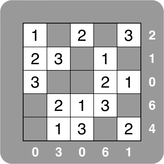What is the origin of the puzzle?
The puzzle was first invented by Kazunori Saito, who contributed an example to the Japan Puzzle Championship 2006. He named it ビトゥイーンサム, meaning "between sum".
The puzzle was invented independently, but later, by the renowned Japanese puzzle inventor Naoki Inaba. He published an example on his website inabapuzzle.com on 12 Oct 2008 under the name ハサムサム (Hasamusamu).
Other names for the puzzle include:
The puzzle was invented independently, but later, by the renowned Japanese puzzle inventor Naoki Inaba. He published an example on his website inabapuzzle.com on 12 Oct 2008 under the name ハサムサム (Hasamusamu).
Other names for the puzzle include:
- Smashed Sums (English-speaking puzzle communities)
- Doppelblock (a German name, but used quite widely)
- Double Block (literal translation of Doppelblock to English)
- Doplo (derived from Doppelblock, used by a Swiss publisher).
What are the principles of the puzzle?

The principles are explained with animated examples in the Instructions section of the introduction built into the app.
Here are the three basic rules:
Here are the three basic rules:
- Every row and every column must contain exactly two filled squares ("blocks").
- The remaining squares contain the numbers 1, 2, 3 (etc.), with each number appearing exactly once in every row and in every column.
- The clues at the ends of the rows and below the columns tell you how the numbers between the blocks add up.
Sometimes, some of the clues are hidden. This usually makes the puzzle harder to solve!
Do you need to be a bit of a mathematician to solve the puzzles?
No. If the puzzles would be played with pencil and paper then it might help to be good at mental arithmetic. But when the puzzles are played in the Sumaddle app, the interactive features provide you with all the information you need to solve the puzzles, without needing to do any sums in your head.
In particular, the app shows you the combinations of numbers that add up to the clue values. It also performs automatic checks on the numbers in play and tells you when the numbers add up correctly (or not). This lets you focus much more on applying logic to find a fit for the blocks and numbers, instead of on adding up.
In particular, the app shows you the combinations of numbers that add up to the clue values. It also performs automatic checks on the numbers in play and tells you when the numbers add up correctly (or not). This lets you focus much more on applying logic to find a fit for the blocks and numbers, instead of on adding up.
What sizes of puzzle are possible?
It is possible to generate puzzles from 3x3 to 10x10. The Sumaddle app features puzzles across the range 4x4 to 9x9.
Can a puzzle have more than one solution?
No, each puzzle has only one unique solution.
